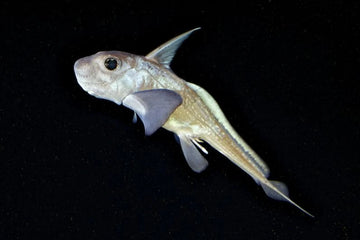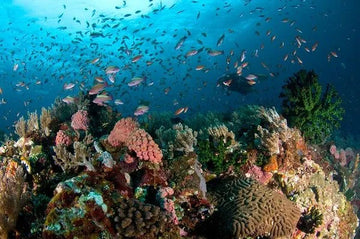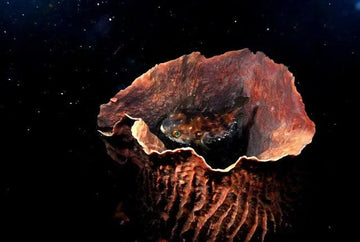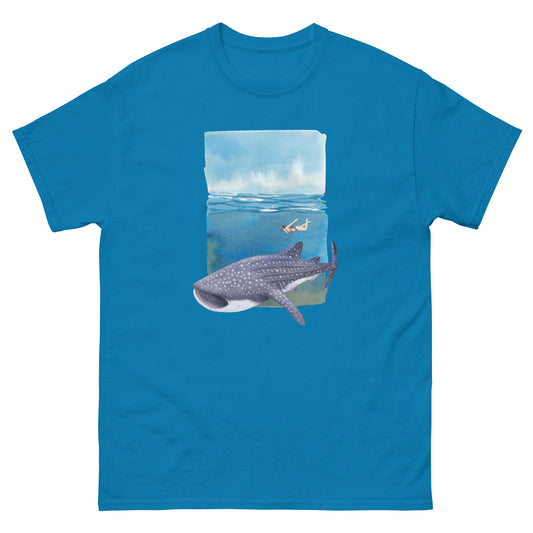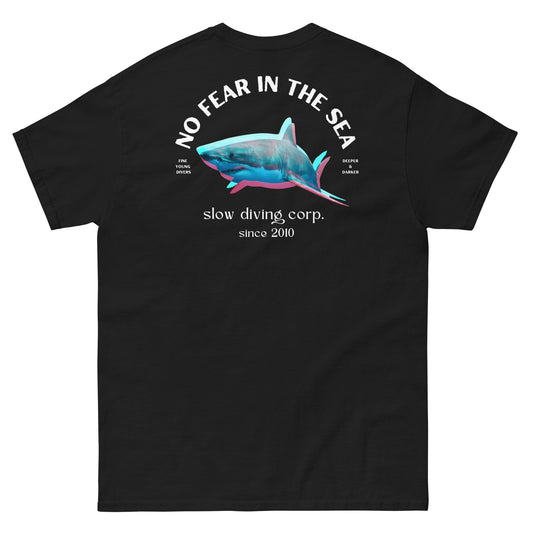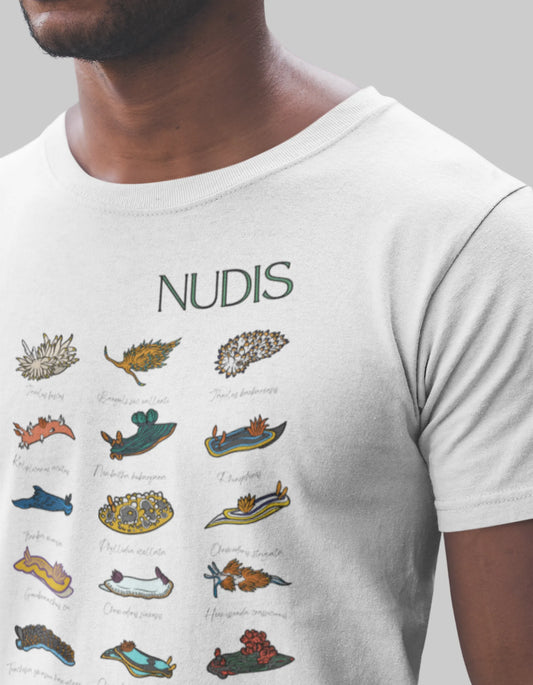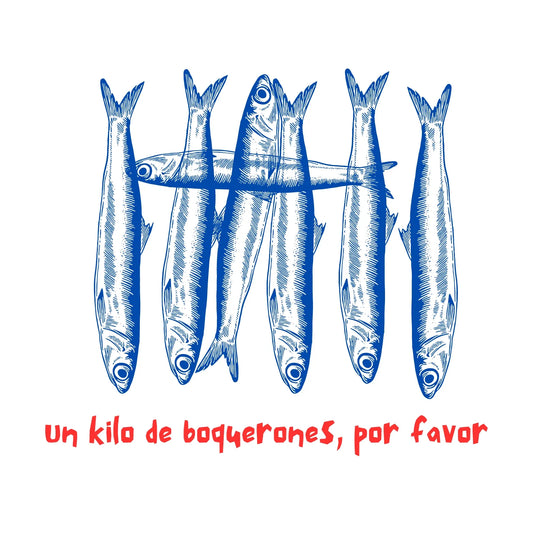In the deep sea we find beings that have managed to adapt to extremely difficult conditions for life. From a depth of 1,000 meters, there are species that have evolved to survive in total darkness, with pressures above 100 atmospheres, with little access to food, low oxygen concentrations and temperatures close to just 4ºC.
For ocean lovers like you, we have created this collection of T-shirts for sea enthusiasts. Top-quality shirts with worldwide shipping.
These 7 species that inhabit this Batial zone of about 1,000 meters deep are surprising for the adaptations they have undergone and that have allowed them to survive in such conditions. All of them have a peculiar aspect that evolution has given them to make this environment their home.
DEMON FISH (BOROSTOMIAS ABYSSORUM)
The Demon fish (Borostomias abyssorum) belongs to the family Stomiidae, deep-sea fishes that have several adaptations that allow them to live safely beyond 1,000 meters. These small fish, up to 26 cm in length, have huge jaws full of sharp teeth and a useful ability to open their jaws to an angle of more than 100 degrees. This ability is common in the bathyal zone, as we will see in other examples. Where food is scarce, no prey, no matter how large, can escape.

Another great adaptation that fish in the devilfish family have is their ability to produce light through bioluminescence. This chemical process is produced in an organ known as a photophore that devilfish have both in an appendage under the mouth and on the sides of their body. They use this ability to attract their prey that approach the light believing it to be food falling from the surface, being devoured by our friend. One last really surprising fact is that devil fish, which also feed on other bioluminescent beings, have opaque patches in their stomachs that allow them to avoid attracting the attention of their predators from inside their guts.
FRILLED SHARK (CHLAMYDOSELACHUS ANGUINEUS)
The frilled shark is one of those rare sharks, unique and little known. They usually live near the bottom, believed to live at depths of around 1,500 meters, but have also been caught by trawlers at depths of only 200 meters.
This shark, up to 2 meters long, is so perfect that it has managed to survive tens of millions of years without almost any change. It is one of those fish that are called "living fossils" because of their primitive characteristics and few alterations.
The frilled shark has rarely been seen alive, but on those few occasions its curious hunting technique has been observed, bending its body to dive for its prey as if it were an eel or a snake.
 Frilled shark (Chlamydoselachus anguineus)
Frilled shark (Chlamydoselachus anguineus)The jaws of the frilled shark are large and flexible so that, like all deep-sea species, they can swallow large prey. Its small, needle-sharp teeth, directed towards the inside of the mouth, prevent prey from escaping. It feeds mainly on cephalopods, bony fish and even other sharks.
One last fact about this shark is that its gestation period can be up to 3.5 years, the longest of all animals.
VAMPIRE SQUID (VAMPYROTEUTHIS INFERNALIS)
The vampire squid (Vampyroteuthis infernalis) is another of these beauties brought from the depths of the ocean that looks like it came from a horror movie set. Despite the video and its menacing image it is a rather small cephalopod that can only grow up to 30 cm in total. And it is not even a big predator!
It was discovered just over 100 years ago and is another striking example of adaptation to such an extreme environment as that between 600 and 1,000 meters, where oxygen saturations only reach 3%. In order to live at these depths, the vampire squid must have a minimum oxygen consumption. Thanks to its weak musculature, great buoyancy and agility, together with the presence of hemocyanin, the protein that efficiently transports oxygen in its blood, it does not need as much oxygen as other cephalopods. In fact, most cephalopods cannot live with oxygen saturations below 15%.
In order to detect both food and predators in these zero light conditions, the vampire squid has two huge eyes that help it detect other bioluminescent prey. Eyes so large that they are actually the largest in the animal kingdom relative to its body size. These big eyes also allow it to detect "marine snow", small fragments of falling organic matter that it feeds on and detects, both by the sight reflected in its bioluminescence and through small tentacles that provide it with great sensitivity.
The most notorious characteristic of the vampire squid that has made it enter this list of beauties is its mantle, the skin that connects its 8 arms. This mantle is covered with rows of spines that, the first time you see it as clearly as in the video, generates an irrational but very intense fear. Can you imagine being the fish that ends up locked in that terrifying mantle from which there is no way out? Our beautiful cephalopod opens and closes it with great skill to "welcome" its victim who can do little to escape as soon as it enters.
Its body is also covered by photophore organs, like the demon fish, which it uses to attract its prey but also to disorient its predators. It is even capable of modulating the intensity and duration of the flashes of its photophores! Undoubtedly our favorite for its extraordinary ability to adapt to the worst conditions for life.
WHITEFIN CHIAMERA (CHIMAERA ARGILOBA)

The whitefin chimaera (Chimaera argiloba) is a species of fish of the chimaera family, cartilaginous fish related to sharks and rays. They inhabit deep waters, although not as much as the other companions in this post. Chimeras move between 370 and 520 meters deep and have a curious shape that, for us, makes them special.
Chimeras do not have anal fins, but rather a kind of thin tail or stinger. If you look at the picture above you can see that it is really peculiar and looks like a mixture of different animals. In fact its name, "chimaera" refers to the monster of classical Greece, a hybrid between goat, snake or dragon for its tail and lion for its head. Yes, its pointed snout sometimes resembles, in profile, that of some dogs.
They are rather small fish, up to a maximum length of 17.3 cm, with a large gill slit. Like sharks, they have electromagnetic sensors distributed throughout the body with which they detect their prey and communicate with other chimaeras, especially during the breeding season.
PELICAN EEL (EURYPHARYNX PELECANOIDES)
The pelican eel (Eurypharynx pelecanoides) is another example that in the deep sea no opportunity, no matter how big, can be missed. The pelican fish has a gigantic mouth, much larger than its body, and a lower jaw so large that it measures about a quarter of the total length of the fish itself. It normally has a folded jaw but is a real spectacle when it inflates and deflates, as captured by The Ocean Exploration Trust's Nautilus:
Why does it have such an immense mouth? When the pelican fish, yes, that's why it's called a pelican, is in search of prey it opens its mouth and the head and jaw structure unfolds and extends horizontally, inflating the mouth and ingesting a large amount of water, thus absorbing organic matter. Either in the form of "marine snow" or invertebrates and even small cephalopods. If it is lucky enough to find a prey as large as itself or larger, it will expand its stomach. Another necessary adaptation in areas of extremely scarce food. It is also believed that one of its hunting techniques is to enter shoals of shrimp or other crustaceans by opening its mouth wide and absorbing a large amount of water full of food.
Studying this type of fish in depth is really complicated since they live in abyssal zones, up to 3,000 meters deep, and they are so fragile that they are greatly damaged when they ascend to areas of lower pressures. We do know that they can measure up to 1 meter, that they do not have a swim bladder, that they have very small eyes (something unusual in the depths where they live) and a very long tail in the shape of a whip that they use to move around.
Like many creatures from areas beyond 1,000 meters, it has bioluminescent organs that it uses to communicate thanks to a complex organ located at the end of the tail with numerous tentacles that emit occasional flashes. It is quite possible that it uses it as a lure to attract prey.
BLACK SWALLOWER (CHIASMODON NIGER)

This is another extreme case of adaptation to food scarcity. The name black swallower (Chiasmodon niger) leaves no room for doubt. This fish lives at depths of 700 to 3,000 meters and does not hesitate to gobble bony fish of any size. At any cost.
Its adaptation is so extraordinary that it has an enormous stomach compared to its body that allows it to swallow prey three times its size. Yes, as if you would eat a whole calf in one bite… or a dog would swallow you whole.
The prey it swallows can be so large that most of the specimens that have been studied have come to us dead from gluttony: their stomachs had burst because of the size of the prey (like the one in the photo) or because the gases generated from digestion were such that they had sent the fish to the surface where, due to lack of pressure, it died.
GOBLIN SHARK (MITSUKURINA OWSTONI)

The goblin shark (Mitsukurina owstoni) is another one of those terrifying beauties of the deep that not only look like something out of a science fiction movie. In this case it inspired a horror classic: Alien. As you can see in the video below, this shark has developed an ability that makes it unstoppable in the lightless depths where it lives. Not only does it have a highly developed nose full of sensors capable of detecting electromagnetic fields, it is also capable of projecting its mouth full of teeth so as not to waste the few opportunities for food that its environment provides.

